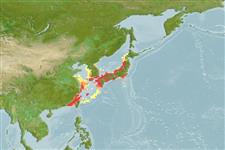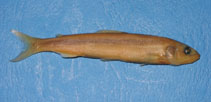Plecoglossus altivelis (Temminck & Schlegel, 1846)
Ayu sweetfish
添加你自己的观测位置在 Fish Watcher
| Native range | All suitable habitat | Point map | Year 2050 |

|
| This map was computer-generated and has not yet been reviewed. |
| Plecoglossus altivelis AquaMaps Data sources: GBIF OBIS |
上传你的 图片 和 影像
Pictures | Stamps, coins, misc. | 谷歌图片Plecoglossus altivelis
Picture by Islam, Md. S.
Pictures | Stamps, coins, misc. | 谷歌图片Plecoglossus altivelis
Picture by Islam, Md. S.
Chinese Taipei (Taiwan) country information
Common names:
[No common name]
Occurrence: introduced
Salinity: freshwater
Abundance: | Ref:
Importance: minor commercial | Ref: FAO, 2000
Aquaculture: commercial | Ref: Liao, C.-I., H.-M. Su and E.Y. Chang, 2001
Regulations: | Ref:
Uses: no uses
Comments: Native stock extirpated after manmade damage to environment (Ref. 6300). Existing stocks introduced from Japan (Ref. 5193). Cultivated for local consumption and for export to Japan (Ref. 6300). First successful larviculture in Taiwan occurred in 1979 (Ref. 40297). Also Ref. 559.
National Checklist:
Country Information: https://www.cia.gov/library/publications/resources/the-world-factbook/geos/tw.html
National Fisheries Authority:
Occurrences: Occurrences Point map
Main Ref: Liao, I.-C. and H.-C. Lia, 1989
National Database: The Fish Database of Taiwan
Occurrence: introduced
Salinity: freshwater
Abundance: | Ref:
Importance: minor commercial | Ref: FAO, 2000
Aquaculture: commercial | Ref: Liao, C.-I., H.-M. Su and E.Y. Chang, 2001
Regulations: | Ref:
Uses: no uses
Comments: Native stock extirpated after manmade damage to environment (Ref. 6300). Existing stocks introduced from Japan (Ref. 5193). Cultivated for local consumption and for export to Japan (Ref. 6300). First successful larviculture in Taiwan occurred in 1979 (Ref. 40297). Also Ref. 559.
National Checklist:
Country Information: https://www.cia.gov/library/publications/resources/the-world-factbook/geos/tw.html
National Fisheries Authority:
Occurrences: Occurrences Point map
Main Ref: Liao, I.-C. and H.-C. Lia, 1989
National Database: The Fish Database of Taiwan
Common names from other countries
分类 / Names 俗名 | 同种异名 | Catalog of Fishes(属, 种) | ITIS | CoL | WoRMS | Cloffa
Teleostei > Osmeriformes (Freshwater smelts) > Plecoglossidae (Ayu fish)
Etymology: Plecoglossus: Greek, pleko, plekein = to fold + Greek, glossa = tongue (Ref. 45335).
More on authors: Temminck & Schlegel.
Etymology: Plecoglossus: Greek, pleko, plekein = to fold + Greek, glossa = tongue (Ref. 45335).
More on authors: Temminck & Schlegel.
Issue
All subspecies of Plecoglossus altivelis (Temminck & Schlegel, 1846) are synonymised under the species in Eschmeyer (CofF ver. Jul. 2010: Ref. 84883). Please send references, or more studies are needed.
Environment: milieu / climate zone / depth range / distribution range 生态学
海洋; 淡水; 半咸淡水 居于水底的; 非产卵性溯降河的 (Ref. 51243); 深度上下限 10 - ? m. 亚热带的; 44°N - 23°N
分布 国家 | FAO区域 | 生态系 | 标本纪录 | Point map | 简介 | Faunafri
Northwest Pacific: western Hokkaido in Japan southward to the Korean Peninsula, Taiwan and China.
西北太平洋: 在日本向南至朝鲜半岛,台湾与中国的北海道西部。 一个亚种 琉球香鱼〔Plecoglossus altivelis ryukyuensis〕 出现于 Nansei 中-shoto ,日本.(参考文献 34989)
西北太平洋: 在日本向南至朝鲜半岛,台湾与中国的北海道西部。 一个亚种 琉球香鱼〔Plecoglossus altivelis ryukyuensis〕 出现于 Nansei 中-shoto ,日本.(参考文献 34989)
Length at first maturity / 大小 / 重量 / 年龄
Maturity: Lm 27.5, range 30 - 40 cm
Max length : 70.0 cm TL 雄鱼/尚未辨别雌雄; (Ref. 12218); common length : 15.0 cm SL 雄鱼/尚未辨别雌雄; (Ref. 35840); 最大年龄: 3.00 年 (Ref. 12218)
Max length : 70.0 cm TL 雄鱼/尚未辨别雌雄; (Ref. 12218); common length : 15.0 cm SL 雄鱼/尚未辨别雌雄; (Ref. 35840); 最大年龄: 3.00 年 (Ref. 12218)
简单描述 检索表 | 型态特徵 | 形态测量图
背棘 (总数) : 0; 背的软条 (总数) : 10 - 11; 臀鳍软条: 14 - 15; 脊椎骨: 60 - 63. Pyloric caeca 350-400.
幽门盲囊 350-400.
幽门盲囊 350-400.
Typical amphidromous fish; appears in near shore from late autumn to spring (Ref. 11230). Found in lakes and rivers, preferring clean river water and can be found the entire river long, from the head to the mouth (Ref. 12218). Ascends the river during March when the temperature is around 10°C (Ref. 12218). Adults spawn in the spring, in the lower reaches of rivers. After spawning, some adults die while others return to the sea. Larvae enter the sea immediately after hatching and remain there during winter, feeding on plankton. In springtime, the young (5-7 cm TL) move upstream to the middle reaches of rivers to feed on algae. Fish (about 6-9 cm) start schooling at the river mouth and are insectivores and eat algae
off small pebbles (Ref. 12218); this is assisted by small leaf-like teeth which are loosely attached to the jaw with two ligaments (Ref. 45181). Those that are ready to spawn (about 20 cm TL) move downstream to the lower reaches of the river. Spawning adults from the sea migrate upstream to the lower reaches as well. Some fish spawn two or three years in succession, others only once (Ref. 9987 & 559). River forms live usually only one year whereas lake forms can live two or three years (Ref. 12218). Reaches maturity at 30-40 cm (Ref. 12218). Highly esteemed food fish. Marketed fresh and consumed fresh, fried and broiled (Ref. 9987).
典型的河海两域洄游的鱼; 在从秋季末到春天的近岸出现。 (参考文献 11230) 发现于湖与河了, 偏爱乾净的河水而且被发现于整个的河长的, 从头部对嘴巴.(参考文献 12218) 在温度是大约 10 °C 的三月期间上溯到河。 (参考文献 12218) 成鱼产卵于春天中,在河的下面范围方面。 在产卵之后,当其它回到海洋的时候,一些成鱼死。 仔鱼在孵化之后紧邻进入海洋而且在冬天期间逗留在哪里, 吃浮游生物。 在春天, 幼鱼 (5-7 公分TL) 移动溯河到河的中游觅食藻类。 鱼 (大约 6-9 公分) 开始在河嘴群游而且是食虫动物而且吃藻类 外海的小小圆石;(参考文献 12218) 这被小叶状的齿协助松弛地那是依附于颌有两个结带.(参考文献 45181) 那些那是预备好的状态产卵 (大约 20 公分TL) 移动向下到河的下面范围。 产卵的成鱼距离海洋移动也溯河到下面的范围。 一些鱼在连续方面产卵二或三年, 其它是只有一次 (参考文献 9987&559). 然而湖表格能生活二或三年,河表格通常生活只有一年。 (参考文献 12218) 在 30-40 公分达到成熟。 (参考文献 12218) 深受喜爱的食用鱼。 在市场上销售生鲜地而且生鲜消费, 油炸了而且火烤了。 (参考文献 9987)
典型的河海两域洄游的鱼; 在从秋季末到春天的近岸出现。 (参考文献 11230) 发现于湖与河了, 偏爱乾净的河水而且被发现于整个的河长的, 从头部对嘴巴.(参考文献 12218) 在温度是大约 10 °C 的三月期间上溯到河。 (参考文献 12218) 成鱼产卵于春天中,在河的下面范围方面。 在产卵之后,当其它回到海洋的时候,一些成鱼死。 仔鱼在孵化之后紧邻进入海洋而且在冬天期间逗留在哪里, 吃浮游生物。 在春天, 幼鱼 (5-7 公分TL) 移动溯河到河的中游觅食藻类。 鱼 (大约 6-9 公分) 开始在河嘴群游而且是食虫动物而且吃藻类 外海的小小圆石;(参考文献 12218) 这被小叶状的齿协助松弛地那是依附于颌有两个结带.(参考文献 45181) 那些那是预备好的状态产卵 (大约 20 公分TL) 移动向下到河的下面范围。 产卵的成鱼距离海洋移动也溯河到下面的范围。 一些鱼在连续方面产卵二或三年, 其它是只有一次 (参考文献 9987&559). 然而湖表格能生活二或三年,河表格通常生活只有一年。 (参考文献 12218) 在 30-40 公分达到成熟。 (参考文献 12218) 深受喜爱的食用鱼。 在市场上销售生鲜地而且生鲜消费, 油炸了而且火烤了。 (参考文献 9987)
Life cycle and mating behavior 成熟度 | 繁殖 | 产卵场 | 卵 | 孕卵数 | 仔鱼
During spawning some fish go up the river and some fish spawn on the river shoreline above pebbles. Spawns at night and excavates a 10cm (diameter or depth?) pit. Eggs are around 1 mm in size and adhere to the sand or pebbles for 14 to 20 days before hatching. This fish is semelparous and releases eggs many times over a short period each time releasing ~10,000 eggs. Sometimes females that want to spawn but cannot, save their strength, and go to a deep stagnant pool. These females wait until spring before going up the river with young fish. After hatching, the larvae are 6 mm and flow with the water current eating plankton. Juvenile fish will come again to the river in spring. These live in schools. When schools of Plecoglossus altivelis return to their river they guard their territory and eat food (Ref. 12218).
Reproductive mode varies between semelparity and iteroparity. Large females spawn once, while smaller females spawn twice during a two-week interval (Ref. 76896).西北太平洋: 在日本向南至朝鲜半岛,台湾与中国的北海道西部。 一个亚种 琉球香鱼〔Plecoglossus altivelis ryukyuensis〕 出现于 Nansei 中-shoto ,日本.(参考文献 34989)
主要参考文献
Upload your references | 参考文献 | 合作者 | 合作者
Masuda, H., K. Amaoka, C. Araga, T. Uyeno and T. Yoshino, 1984. The fishes of the Japanese Archipelago. Vol. 1. Tokai University Press, Tokyo, Japan. 437 p. (text). (Ref. 559)
对人类的威胁
无害处的
人类利用
渔业: 高经济性; 养殖: 商业性; 游钓鱼种: 是的
更多信息
Population dynamics
成长参数
Max. ages / sizes
Length-weight rel.
Length-length rel.
体长-频率
Mass conversion
入添量
丰度
成长参数
Max. ages / sizes
Length-weight rel.
Length-length rel.
体长-频率
Mass conversion
入添量
丰度
Anatomy
鳃区
Brain
Otolith
鳃区
Brain
Otolith
Physiology
Body composition
Nutrients
耗氧量
游泳类型
游泳速度
Visual pigments
Fish sound
Diseases & Parasites
Toxicity (LC50s)
Body composition
Nutrients
耗氧量
游泳类型
游泳速度
Visual pigments
Fish sound
Diseases & Parasites
Toxicity (LC50s)
工具
E-book | 野外调查 | 长度- 频率 Wizard | 生活- 历史的工具 | 分布图 | Classification Tree
| Catch-MSY |
特别资料
下载 XML
网络资源
Alien/Invasive Species database | Aquatic Commons | BHL | Cloffa | BOLDSystems | Websites from users | 核实 FishWatcher | CISTI | Catalog of Fishes(属, 种) | DiscoverLife | ECOTOX | Faunafri | Fishtrace | GenBank(基因组, 核苷酸) | GloBI | GOBASE | | Google Books | Google Scholar | Google | IGFA World Record | MitoFish | 国家资料库 | Otolith Atlas of Taiwan Fishes | PubMed | Reef Life Survey | Scirus | SeaLifeBase | 树状分类阶层 | Wikipedia(转至, 搜寻) | World Records Freshwater Fishing | 动物学的记录
Estimates based on models
Preferred temperature (Ref. 115969): 13 - 22.6, mean 19.7 (based on 42 cells).
Phylogenetic diversity index (Ref. 82804): PD50 = 1.5000 [Uniqueness, from 0.5 = low to 2.0 = high].
Bayesian length-weight: a=0.00427 (0.00166 - 0.01096), b=3.06 (2.83 - 3.29), in cm Total Length, based on LWR estimates for this (Sub)family-body shape (Ref. 93245).
营养阶层 (Ref. 69278): 2.8 ±0.16 se; based on food items.
回复力 (Ref. 120179): 高度, 族群倍增时间少于 15个月 (tm=1; tmax=3; Fec=50,000-100,000).
Fishing Vulnerability (Ref. 59153): Moderate to high vulnerability (48 of 100).




